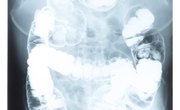
The human body is made up of multiple systems that work together to form life. Body systems are an organized group of tissue that forms a particular function. These functions work with other systems in the body. Some of the main systems of the body are digestive, circulatory, nervous, respiratory and muscular. Understanding these systems helps people know how the body functions and why the health of each of them is important for overall quality of life.
Circulatory
The circulatory system is responsible for delivery of oxygen and nutrients to the tissue in the organs. All cells in the body require oxygen for cellular reactions. This oxygen, along with the biomolecules from the foods we eat, are used to produce energy. The heart is also a part of this system. The heart is responsible for retrieving deoxygenated blood, pumping it to the lungs and then sending it through the arteries throughout the body.
Respiratory
The respiratory system is the part of the body that processes gas exchange. When the body inhales, the air fills the lungs. The alveoli in the lungs are small balloons that fill with air. These balloons are surrounded by capillaries of deoxygenated blood pumped by the heart. The alveoli gives the blood the oxygen from inhaling and then receives the carbon dioxide, which is a waste product of metabolism. When the body exhales, the carbon dioxide is sent back out of the mouth, and the process is repeated.
Digestive
Digestion is the system responsible for breakdown of biomolecules. Biomolecules such as carbohydrates (sugars), proteins and lipids (fats) are absorbed in the small intestine and delivered to the blood. The digestive system is a long path that starts from the mouth and ends at the anus. Food travels down the esophagus to the stomach, where gastric juices begin the process of breakdown. The food is sent to the small intestine, where pancreatic enzymes break down food into smaller components for absorption. Finally, waste products are sent to the colon and excreted through the anus.
Muscular
The muscular system is the muscles throughout the body that control movement. Most people initially label the muscular system as the muscles we know on our arms, legs and stomach. These muscles are called skeletal muscles. However, there are two other major groups of muscles. Smooth muscle is found in places like the esophagus, where food is pushed from the mouth to the stomach. Smooth muscle is also located in the intestines. The other type of muscle is cardiac muscle. Cardiac muscle is found in the heart.
Nervous
The nervous system is the "control switch" of the body. The nervous system is made up of the brain, spinal cord and the peripheral nerves that span to locations throughout the body. The nervous system retrieves environmental input such as heat, touch, sound, and sight and sends it to the brain. The brain processes the input and sends output back to the body using efferent nerves. These nerves are what control reactions such as walking, talking and waving arms.
References
About the Author
Lysis is the pen name for a former computer programmer and network administrator who now studies biochemistry and biology while ghostwriting for clients. She currently studies health, medicine and autoimmune disorders. Lysis is currently pursuing a Ph.D. in genetic engineering.
